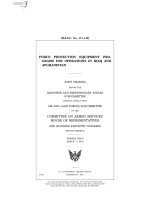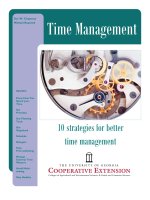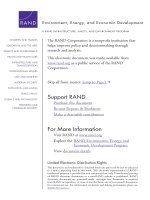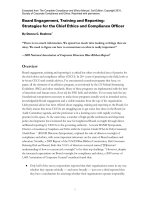slide strategies for operations abroad
Bạn đang xem bản rút gọn của tài liệu. Xem và tải ngay bản đầy đủ của tài liệu tại đây (169.71 KB, 20 trang )
Corruption in
China
International Marketing
Monday April 14th, 2003
Rebecca Hall
Sara Hearl
George Chandy
Nita Ng
Ingrid Chen
Overview
•
Strategies for Operations Abroad
•
Selective Contestability
•
Defining a Global Company
•
Nestle Evaluation
•
Summary
•
International
–
Control remains predominately with HQ in
home county
–
Low pressure for local responsiveness-high
pressure cost reductions
•
Multidomestic
–
Customize operations and products to
each local market
–
High local responsiveness-low pressure
cost reductions
Strategies for
Operations Abroad
•
Global
–
Tendency to centralize main operational functions
–
Can mobilize world-wide resources
–
High cost reductions from economies of scale
and experience curve-low customization to
national borders
•
Transnational
–
Looking for ‘global learning’ from HQ to
subsidiaries, in reverse and between subsidiaries
–
Cost reductions and product differentiation
Strategies for
Operations Abroad
•
Globalization Vs localization
•
Global integration vs. local responsiveness
•
“Think Global, Act Local”
•
There may be trade off between cost
reductions of standardization and marketing
ideals of customization to the market’s needs
Global Strategy
•
To go global or not?
•
Compelling Reasons
–
Diversity of earnings
–
Exposure to new and emerging markets
–
Experience curve and access to the most
demanding customers
Global Strategy
•
The rise of globalization and the increased
information flow across national borders
has lead to the reassessment of the very
notion of market borders
•
National boarders are not the only
indication of market segmentation
•
Global marketers are looking to new ways
of segmentation
–
income, religion, age, language, climate
Global Strategy
•
Is it a global company?
•
Not about size, or the number of
countries it operates in
•
Two key indicators of a global company
–
a company that can contest any market it
chooses to compete in
–
a company that can mobilize worldwide
resources to impact any competitive
situation it chooses
Global Strategy
•
Companies are selective about the
countries they enter.
•
Small High-technology companies and
luxury goods manufacturers
•
They compete if there is adequate
demand to justify their investment
•
They focus their investment to achieve
critical mass only in the markets they
are interested in
Selective Contestability
•
How practical is the idea for small
international companies?
–
Risk factor is low
–
Entry will depend on the existing demand
Selective Contestability
•
Defined in terms of ability to
operationalize a strategy encompassing
the 5 following attributes:
•
Standard Products and Marketing Mix
–
Core product and minimum marketing
adaptations
–
Economies of scale benefits
–
Segmentation cross national borders
Defining a Global
Company
•
Sourcing all Assets on an Optimal Basis
–
Ability to source all assets in value chain in
terms of availability or cost-competitiveness
–
Importance of assets deployment
•
Market Access in Line with Break-Even
Volume
–
Size not as important as generation of sales to
cover demands of infrastructure and investment
Defining a Global
Company
•
Contesting Assets
–
Ability to neutralize the assets and
competencies of competitors
•
Global Orientation of Functions
–
R&D, procurement, production, logistics,
marketing, human resources and finance
functions internationalized
–
organizational structure
Defining a Global
Company
•
No absolutes in terms of what
constitutes a global company or
strategy
•
The greater company’s ability to
operationalize the 5 attributes the more
global it is considered
•
Best to have a balance across attributes
rather than stressing one to the
detriment of another
Degrees of Globalness
•
Standard Products and Marketing Mix
–
Nescafe instant coffee, Perrier bottled water,
breakfast cereals including Cheerios, Kit Kat
bars, Stouffers prepared meals, Bouitoni
pasta and Maggi cooking sauces.
–
Use local brands for market entry
•
Sourcing Assets, Not Just Products
–
Build plants abroad
–
Purchase local companies
•
Goplana in Poland
Nestle Evaluation
•
Market Access inline with Break Even
–
Forced to seek growth opportunities
outside of Switzerland
–
Regionally focused operations
•
Contesting Assets
–
Does not apply - local for local
Nestle Evaluation
•
Functions have a Global Orientation
–
7 world wide strategic business units (SBUs)
•
E.g. Coffee & beverages, confectionery & ice-creams.
–
5 regional organizations
•
E.g Network of factories in the Middle East: ice-cream in
Dubai, soups and cereals in Saudi Arabia, yogurt and
bouillon in Egypt, chocolate in Turkey and ketchup and
instant noodles in Syria.
–
Expatriates army of about 700 managers going
from country to country
–
R&D:18 different groups operating in 11 countries
–
International training center in Switzerland
Nestle Evaluation
•
Nestle adopts a matrix organization
highly decentralized decision making
Nestle Evaluation
SBU1 SBU2 SBU3 SBU4 SBU5 SBU6 SBU7
North America
Europe
Asia
Africa
Middle-East
SBUs
Regions
•
Conclusion
–
Nestle management philosophy is to
“develop as much as can be decided
locally, but the interest of the corporation
as a whole has priority”
–
Due to the industry Nestle is in, it is
perhaps undesirable for it to become fully
global
–
Nestle’s aim is to customize to the local
tastes
Nestle Evaluation
•
Global marketing reflects:
–
competitiveness due to globalization
–
interdependence of world’s economies
–
growing number of firms vying for world
markets
•
Global Strategy
–
Dual notion of market contestability and
bringing global resources to bear on
competition wherever a company is present
•
Global Companies look at segmentation on a
global basis (one market)
Summary









